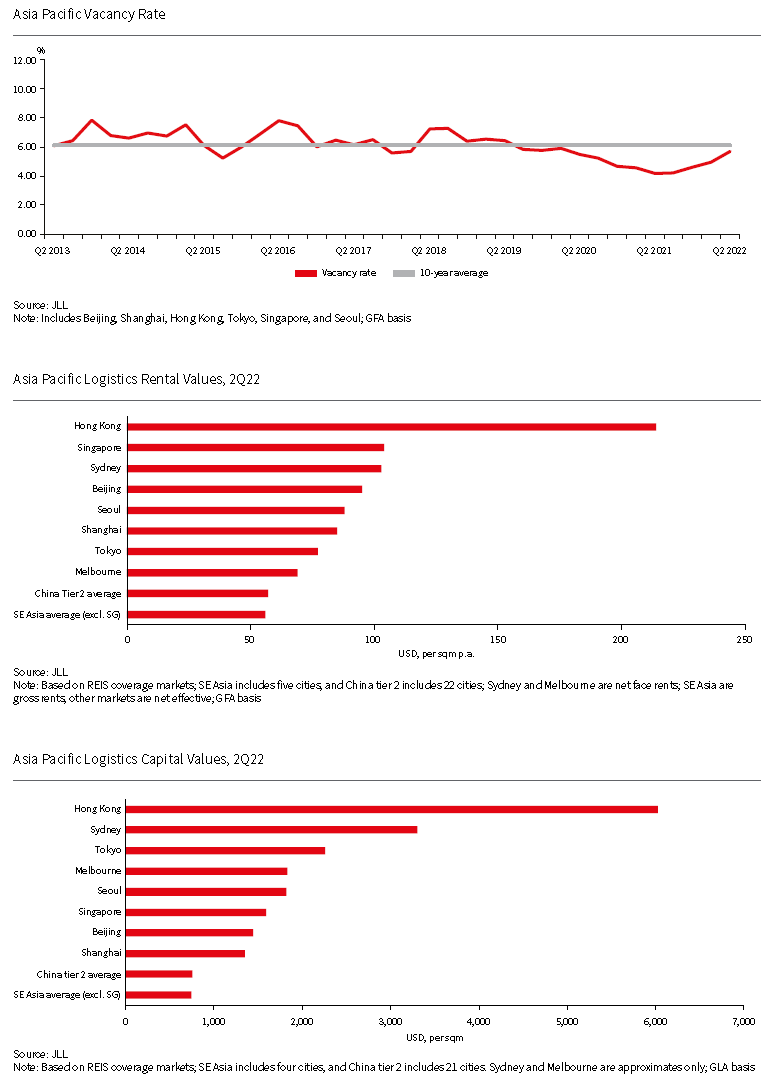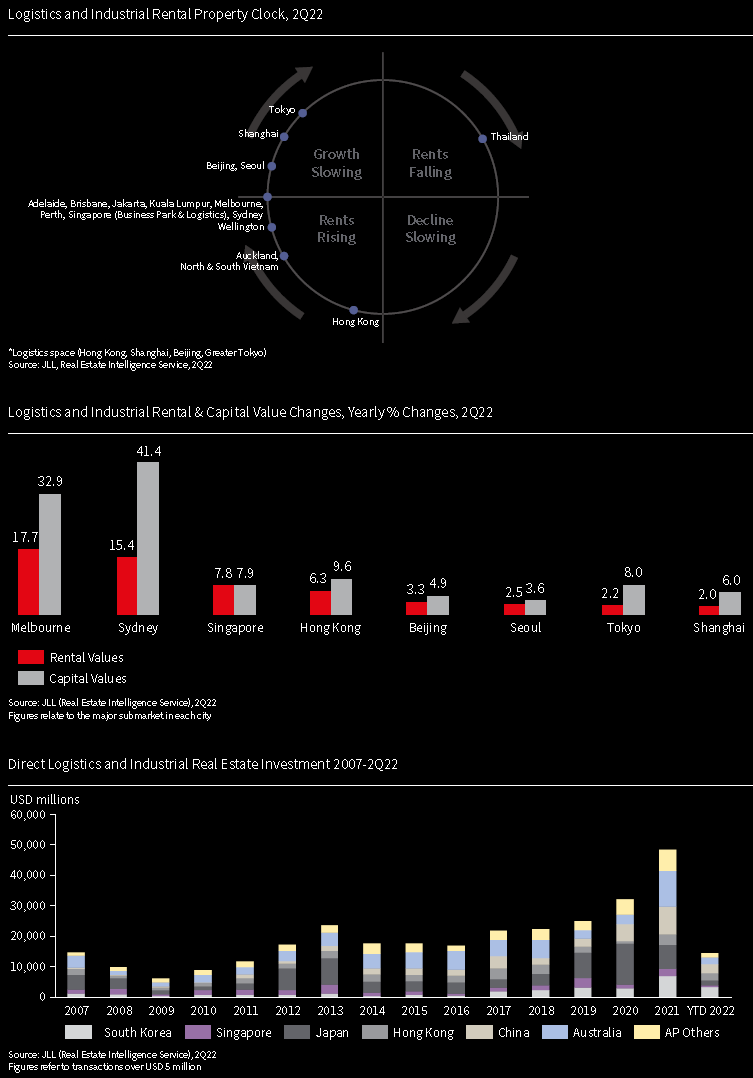Logistics and Industrial Market Insights - JLL
Contact
Logistics and Industrial Market Insights - JLL
The strong start to the year continued in 2Q22. Demand levels remain steady, supported by e-commerce and 3PL take-up. Demand is also broadening and deepening across other sectors. Cold storage operators, supermarket chains, retailers and biomedicine groups are increasingly taking more space.
Supply places upward pressure on vacancy but demand remains solid
The strong start to the year continued in 2Q22. Demand levels remain steady, supported by e-commerce and 3PL take-up. Demand is also broadening and deepening across other sectors. Cold storage operators, supermarket chains, retailers and biomedicine groups are increasingly taking more space. In terms of the key market level trends – strict lockdown measures put a pause on activity in China, particularly in Shanghai; limited availability of prime space in core locations limited take-up in Tokyo, but sentiment is very positive; and demand in Australia remains elevated, driven by occupiers looking for short-term accommodation solutions and longer-term strategic adjustments to their supply chains. On the supply side, the cycle remains robust – supply this year of 22 million sqm will be the highest on record, and an even larger 25 million sqm is expected next year. However, rising construction costs and interest rates may moderate this near-term pipeline. Generally, supply is concentrated in a few markets such as Korea and Japan, and there remains a broad undersupply of prime grade space in core locations. Nonetheless, vacancy rose in 2Q22. While vacancy will rise further, it will trend down shortly afterwards as space is absorbed in the subsequent quarters after projects complete.
Rents grow at fastest pace in three years
Rental growth is continuing to gather pace, with AP-wide rents rising 4.9% y-o-y. This is the fastest pace of growth in almost three years. In the current environment, despite rising vacancy pressures, demand remains steady, and vacancy remains below the long-term average across mature markets. There is also a fundamental undersupply of prime space in core locations in markets such as Tokyo and Sydney, while large-scale cold storage retrofits in high-quality regions in Beijing increased the scarcity of normal warehouse facilities. Rents increased modestly in the quarter in Tokyo, and increased at a faster pace in Singapore, amid continued stiff competition for space, especially for better quality premises. Lack of industrial-zoned land for expansion and available stock on the market is driving very strong rental growth in Sydney and Melbourne.
More caution across capital markets
Macroeconomic headwinds have slowed transactional activity from last years’ record high, but volumes are still very strong from a historical perspective. Sentiment remains steady, but there may be more caution as investors take stock of the macroenvironment. Pricing and yields are under more pressure in markets where policy rates have tightened. L&I volumes reached around USD 15 billion in 1H22, down from the USD 23 billion in 1H21. That said, this is still a strong half-year result from a historical perspective, being the second-highest first half-year on record. Korea, Australia and Singapore are viewed with more caution by investors with the yield compression effectively coming to an end. However, markets in China, Japan and SEA are still expected to record some modest compression in 2022 and 2023.
Increasing headwinds, but still positive outlook
Increasing macroeconomic headwinds emerged in the second quarter of 2022. Rising interest rates and debt costs, increasing inflation and construction costs, and geopolitical issues are weighing on real estate markets. However, L&I occupier demand has remained resilient. Demand levels over the next 6-12 months are expected to remain steady, supported by higher e-commerce penetration rates. Demand is also anticipated to broaden to other sectors such as from cold storage operators and supermarket chains, amongst others. This will support higher rental growth in 2022, and to a lesser extent in 2023. Full 2022 calendar year growth is expected at 5.5% across Asia Pacific, and by a much faster 8.1% across mature markets. This is despite rising future supply, a large proportion of which will be concentrated in a few markets. Investment activity will likely continue to slow relative to last year’s record high volume for the region. Macro-headwinds will weigh on sentiment, particularly in markets where central banks have adopted a more aggressive tightening monetary policy stance.


The Logistics and Industrial Market Insights report By Roddy Allan, Peter Guevarra of JLL.
Visit here to access the Logistics and Industrial Market Insights Report.







